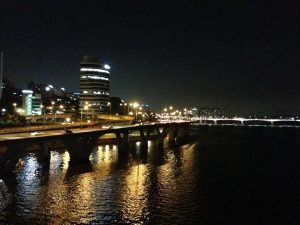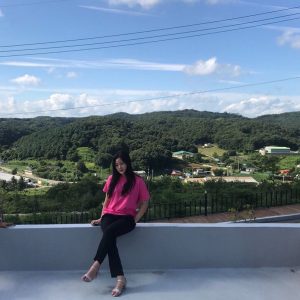Prompt: Write a blog that hyper-links your research on the characters in GGRW using at least 10 pages of the text of your choice. Be sure to make use of Jane Flicks’ GGRW reading notes on your reading list
I decided to work with page 35-50 of Thomas King’s Green Grass, Running Water.
Coyote
Coyote is the narrator who starts the story and makes the story transitions. According to Jane Flick’s note, coyote is “a race of mythic prototypes who lived before humans existed”. They hold lots of powers as they are responsible for creating the world we know now. In the beginning of the story Coyote has an important part in setting the tone of the story. It gives readers the feeling of what the story is going to look like, setting the tone of the story. Coyote’s character gives the allusion that the story is going to tell about the Indigenous storytelling by beginning the story with creation myth with Coyote, not the God as the creator from the Christian theology.
GOD/Dog
When the dog is spelled backwards, it is god, but dogs and god have different feeling to it. When thinking about God, it is associated with being a power creator that is at the top of the hierarchy who created the world but compared to that dog is something small, cute and unpowerful. Flick points out that dogs are essentially just a lesser form of a coyote. The dog who is called GOD is a childish and immature character that the Coyote has to quiet down. It is inferior to Coyote. This gives the readers an implication that God from the Judeo-Christian religion is just like one of the many characters that can be seen in the creation story and it is not the one and only powerful character.
Ahdamn
Ahdamn is a very obvious satire reference to the biblical Adam in the Adam and Eve Genesis story. Unlike the Adam in the bible, Ahdamn lives at the Garden after the First woman. He is simply there to live with her at her garden, but then he tries to take power in the Garden by attempting to attribute names to the animals which he miserably fails to. He is portrayed as a very unintelligent character who is powerless compared to the First Woman who is a strongly Indigenous symbol. King tries to show that Judeo-Christian story cannot empower and take away the Indigenous identity and story through the Ahdamn’s failure to take power in what was already accomplished in the Garden by the First Woman.
Works Cited
BibleGateway. “Genesis 2:4-3:24.” www.biblegateway.com/passage/?search=Genesis 2:4-3:24&version=NIV
Flick, Jane. “Reading Notes for Thomas King’s Green Grass, Running Water.” Canadian Literature, vol. 161/162, 1999, pp. 140-172
King, Thomas. Green Grass Running Water. Toronto: Harper Collins, 1993. ebook
“Native American Coyote Mythology.” Native American Indian Coyote Legends, Meaning and Symbolism from the Myths of Many Tribes, www.native-languages.org/legends-coyote.htm
“Native American Dog Mythology.” Native American Indian Dog Legends, Meaning and Symbolism from the Myths of Many Tribes, www.native-languages.org/legends-dogs.htm

 After a cold winter passed, warm spring came. One day, a stranded puppy who was limping on one leg and looking lost came into Charles’s house to rest. He took a corner of Charles’s large backyard and lied down, shivering in pain. When Charles saw the puppy, he yelled with a bat on his hand “Get lost! There is no room for you to rest!” He swung the bat at the puppy, purposefully hitting the wounded leg. The puppy screamed in pain and ran away.
After a cold winter passed, warm spring came. One day, a stranded puppy who was limping on one leg and looking lost came into Charles’s house to rest. He took a corner of Charles’s large backyard and lied down, shivering in pain. When Charles saw the puppy, he yelled with a bat on his hand “Get lost! There is no room for you to rest!” He swung the bat at the puppy, purposefully hitting the wounded leg. The puppy screamed in pain and ran away. A year passed since then and when spring came again, the puppy came back and sat in front of Sam’s house, waving his tail. Sam greeted the puppy with excitement and petted the puppy’s head. The puppy then dropped something on Sam’s hand from his mouth and ran off. It was a small seed. Sam planted the seed in his backyard and took care of it until it grew into a tree. There were strange fruits that Sam had never seen growing on the tree. Once the tree was full of fruits, fruits started to fall off from the tree one by one. Sam picked up one of the fruits that was on the ground. When Sam picked up the fruit, it cracked open in half and jewels and money popped out from the fruit.
A year passed since then and when spring came again, the puppy came back and sat in front of Sam’s house, waving his tail. Sam greeted the puppy with excitement and petted the puppy’s head. The puppy then dropped something on Sam’s hand from his mouth and ran off. It was a small seed. Sam planted the seed in his backyard and took care of it until it grew into a tree. There were strange fruits that Sam had never seen growing on the tree. Once the tree was full of fruits, fruits started to fall off from the tree one by one. Sam picked up one of the fruits that was on the ground. When Sam picked up the fruit, it cracked open in half and jewels and money popped out from the fruit. Social media as a storytelling format has broken down some of the boundaries and built a sense of a community. As Chamberlin states “words make us feel closer to the world we live in,” (1) and social media has further made people feel connection to the world by words. Traditionally, there was only a one-way relationship between a reader and author, but now social media allows for unlimited publication and boundless sharing from many people. Platforms such as Facebook, Twitter, Instagram and Blogs allow for anyone to freely share their thoughts, opinions and join in the discussions. People are able to find and connect with those who have the same interest easily through hashtags, commonly liked pages and search engines. One can personalized what they like to see on their social media by only “following” the works they are interested in and can connect with others who have the same interest through messaging or commenting on each other’s post or comment. Showing support for someone’s work can be easily done by following the person, re-sharing their post and/or liking the post. Because internet is easily accessible and less time consuming compared to getting in touch with people offline, creation of communities on a large-scale number of people are done relatively easily and fast through constant updates and uploads done online.
Social media as a storytelling format has broken down some of the boundaries and built a sense of a community. As Chamberlin states “words make us feel closer to the world we live in,” (1) and social media has further made people feel connection to the world by words. Traditionally, there was only a one-way relationship between a reader and author, but now social media allows for unlimited publication and boundless sharing from many people. Platforms such as Facebook, Twitter, Instagram and Blogs allow for anyone to freely share their thoughts, opinions and join in the discussions. People are able to find and connect with those who have the same interest easily through hashtags, commonly liked pages and search engines. One can personalized what they like to see on their social media by only “following” the works they are interested in and can connect with others who have the same interest through messaging or commenting on each other’s post or comment. Showing support for someone’s work can be easily done by following the person, re-sharing their post and/or liking the post. Because internet is easily accessible and less time consuming compared to getting in touch with people offline, creation of communities on a large-scale number of people are done relatively easily and fast through constant updates and uploads done online.
 Hello Everyone!
Hello Everyone!